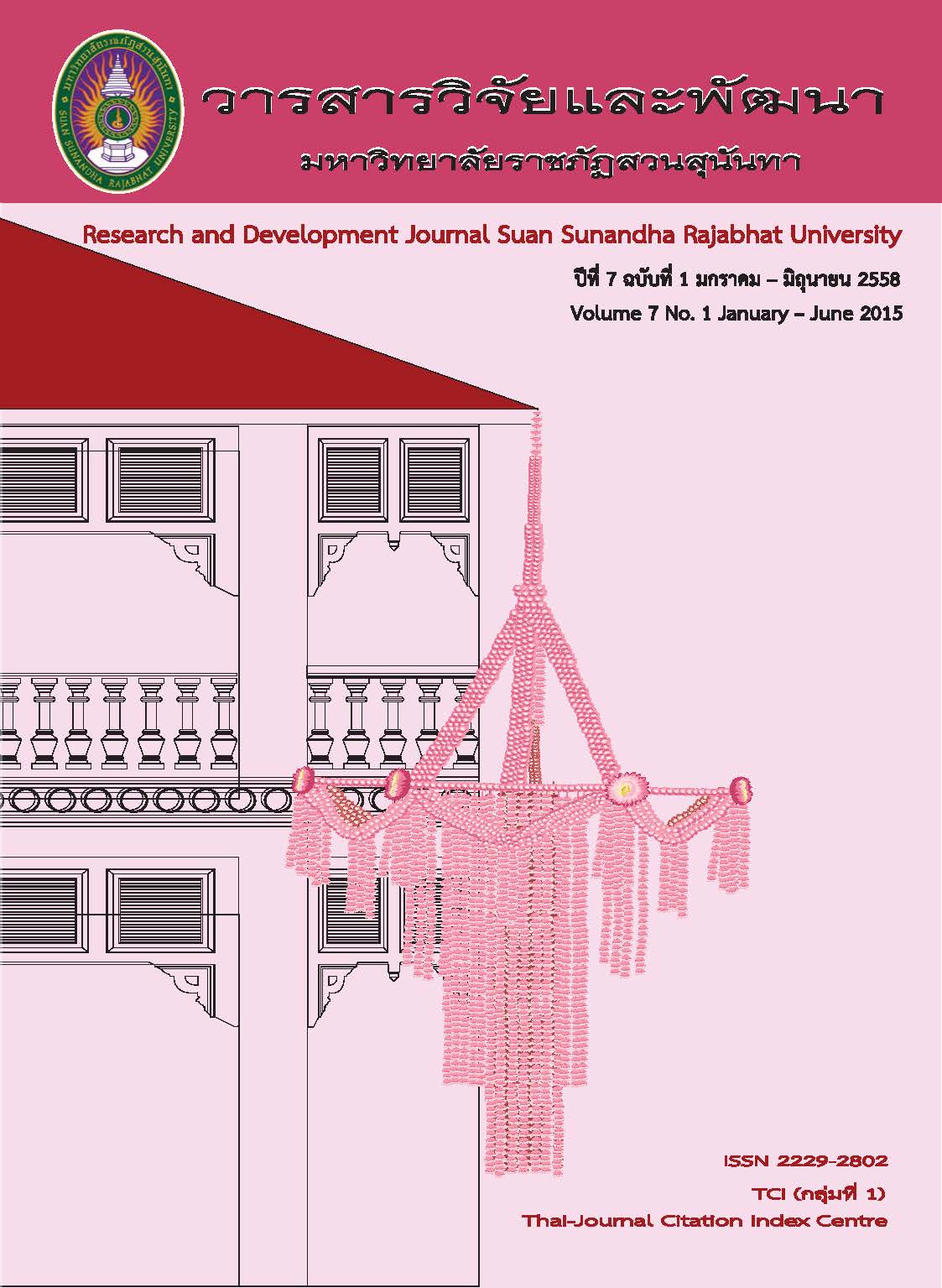ผลของการให้ข้อมูลย้อนกลับเพื่อการแก้ไขทางอ้อมด้วยสัญลักษณ์ ร่วมกับการเยียวยาข้อผิด ต่อข้อผิดทางการเขียนภาษาอังกฤษที่พบบ่อย
DOI:
https://doi.org/10.53848/irdssru.v7i1.214583คำสำคัญ:
การให้ข้อมูลย้อนกลับเพื่อการแก้ไขทางอ้อมด้วยสัญลักษณ์, การแก้ข้อผิด, การเยียวยาข้อผิด, ข้อผิดทางการเขียนภาษาอังกฤษที่พบบ่อยบทคัดย่อ
วัตถุประสงค์ของงานวิจัยนี้ คือ 1) เพื่อศึกษาข้อผิดทางการเขียนภาษาอังกฤษที่พบบ่อยของนักศึกษาที่ลงทะเบียนเรียนรายวิชา การอ่านและการเขียนภาษาอังกฤษเชิงวิชาการ 2 และ 2) เพื่อศึกษาผลของวิธีการแก้ข้อผิดโดยการให้ข้อมูลย้อนกลับเพื่อการแก้ไขทางอ้อมด้วยสัญลักษณ์ร่วมกับกิจกรรมการเยียวยาข้อ
ผิดในด้านความสามารถทางการเขียนของนักศึกษาและปริมาณของข้อผิดดังกล่าว การวิจัยครั้งนี้เป็นการวิจัยกึ่งทดลอง เก็บข้อมูล 5 ครั้งในช่วงเวลาที่ต่างกัน ทั้งก่อนและหลังการทดลองรวม 4 ครั้ง กลุ่มตัวอย่าง เป็นนักศึกษาสาขาวิชาภาษาอังกฤษ ชั้นปีที่ 2 คณะครุศาสตร์ มหาวิทยาลัยราชภัฏสวนสุนันทา จำนวน 52 คน ที่ลงทะเบียนเรียนรายวิชาการอ่านและการเขียนภาษาอังกฤษเชิงวิชาการ 2 ภาคเรียนที่ 1/2556 เครื่องมือวิจัยประกอบด้วย แผนการสอน แบบทดสอบการเขียนข้อความภาษาอังกฤษสั้นๆ 5 ฉบับ
ผลการวิจัยพบว่า ข้อผิดทางการเขียนภาษาอังกฤษที่พบบ่อยประกอบด้วยข้อผิดทางไวยากรณ์ 7 ประเภท นอกจากนี้ ผลการเปรียบเทียบคะแนนผลสัมฤทธิ์จากการประเมินรวบยอดภายหลังการเรียนการเขียนครั้งสุดท้ายกับคะแนนก่อนการทดลองพบว่า ความสามารถทางการเขียนข้อความภาษาอังกฤษสั้นๆของนักศึกษาหลังการทดลองสูงกว่าก่อนการทดลองอย่างมีนัยสำคัญทางสถิติที่ระดับ 0.05 และจำนวนข้อผิดด้านการเขียนภาษาอังกฤษที่พบบ่อยในงานเขียนของนักศึกษาลดลงโดยภาพรวม
เอกสารอ้างอิง
and why? Canadian Journal of Applied
Linguistics. CJAL 2010, 13, pp. 95-127.
Atai, M. The Impact of Self, Peer, and Teacher Evaluation on Iranian EFL Students’ Writing Performance. Islamic Azad University of Karaj. Unpublished M.A. Thesis, 2000.
Bitchener, J., & Knoch, U. The value of a
focused approach to written corrective feedback. ELT Journal, 69, 2009, pp. 204-211.
Bitchener, J., Young, S. & Cameron, D. The effect of different types of corrective feedback on ESL students writing. Journal of Second Language Writing, 14 (3), 2005, pp. 191-205.
Ellis, R., Sheen, Y., Murakami, M., & Takashima, H. The effects of focused and unfocused written correction feedback in an English as a foreign language context. System, 36, 2008, pp. 353-371.
Mutsuda, P. K. Teaching Writing as a Nonnative Speaking Teacher. Conference Handbook, 2014. The 34th Annual Thailand TESOL International Conference, Bangkok, Thailand. Paran, A. Language skills: questions for teaching and learning. ELT Journal, 66, 2012, (4), pp. 450- 458.
Roebuck, R. F. Teaching Composition in the
College Level Foreign Language Class. Insights and Activities from Sociocultural Theory. Foreign Language Annuals. 34 (3), 2001, pp. 206-215.
Scrivener, J. 1998. Learning Teaching. Oxford:
Macmillan Heinemann.
Thornbury, S. Reformulation and reconstruction; tasks that promote ‘noticing’. ELT Journal, 51,
1997, pp. 326-335.
Tompkins, G. E. 2008. Teaching Writing,
Balancing Process and Product. NewJersey: Pearson.
Waters, A. Trends and issues in ELT methods and methodology. ELT Journal, 66(4), 2012, pp. 440- 449.
Yamane, Taro. 1976. Statistic: An Introduction Analysis. 2nd edition. New York : Harper and Row.
เผยแพร่แล้ว
รูปแบบการอ้างอิง
ฉบับ
ประเภทบทความ
สัญญาอนุญาต
บทความที่ได้รับการตีพิมพ์เป็นลิขสิทธิ์ของ สถาบันวิจัยและพัฒนา มหาวิทยาลัยราชภัฎสวนสุนันทา
ข้อความที่ปรากฏในบทความแต่ละเรื่องในวารสารวิชาการเล่มนี้เป็นความคิดเห็นส่วนตัวของผู้เขียนแต่ละท่านไม่เกี่ยวข้องกับมหาวิทยาลัยราชภัฎสวนสุนันทา และคณาจารย์ท่านอื่นๆในมหาวิทยาลัยฯ แต่อย่างใด ความรับผิดชอบองค์ประกอบทั้งหมดของบทความแต่ละเรื่องเป็นของผู้เขียนแต่ละท่าน หากมีความผิดพลาดใดๆ ผู้เขียนแต่ละท่านจะรับผิดชอบบทความของตนเองแต่ผู้เดียว





